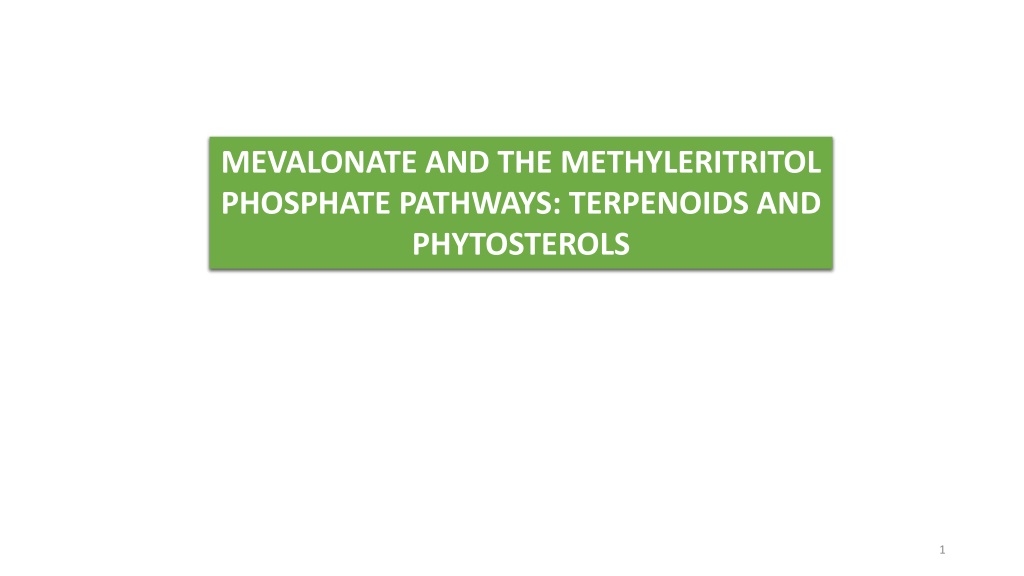

0 likes | 2 Views
Terpenoids, the largest class of plant secondary metabolites, exhibit vast structural diversity and are synthesized through the mevalonate and methylerythritol phosphate pathways. Terpenoids play essential ecological roles in defense mechanisms and attraction of pollinators. The biosynthesis involves the synthesis of IPP and DMAPP, condensation of C5 units to form prenyl diphosphates, and subsequent conversions to various terpenoid classes. The mevalonate pathway produces sesquiterpenes and sterols, while the MEP pathway generates monoterpenes, diterpenes, and more. Plants can utilize both pathways simultaneously in different compartments to produce a wide array of terpenoid compounds.

E N D
MEVALONATE AND THE METHYLERITRITOL PHOSPHATE PATHWAYS: TERPENOIDS AND PHYTOSTEROLS 1
The largest class of plant secondary metabolites is that of terpenoids. Terpenoids are not only numerous but also extremely variable in structure, exhibiting hundreds of different carbon skeletons and a large assortment of functional group. Over 36,000 natural compounds of this class have been reported. In spite of such diversity and complexity, all terpenoids are unified by a common mode of biosynthesis: the fusion of C5 units with an isoprenoid structure. The so-called isoprene rule states that all terpenoids are derived from the ordered head-to –tail joining of isoprene units. Proteins can also contain terpenoid fragments that make increase the lipophilicity of the protein. 2
Isoprene units n Carbon atoms n Name Example 1 5 Hemiterpenes Isoprene 2 10 Monoterpenes Pulegone 3 15 Sesquiterpenes Polygodial 4 20 Diterpenes Paclitaxel 5 25 Sesterterpenes b-Amyrin 6 30 Triterpenes b-Carotene 8 40 Tetraterpenes 9-30,000 More than 40 Polyterpenes Rubber The calssification of terpenoids is based on the number of C5isoprenoid units in their structures 3
They are thought to serve primarily in ecological roles, providing defence against herbivores or pathogens and acting as attractants for animals that disperse pollen or seeds or as inhibitors of germination and neighbouring plants. For example, one of best-known terpene involved in plant defence is polygodial, found in Polygonum hydropiper. It ihnibits the feeding of a diverse assortment of herbivorous insects. The deterrent effect derives from the action of polygodial on taste receptors: the aldeyde groups can covalently bound with the free amino groups of integral membrane proteins. Such modification changes protein structures altering their bioactivity. Polygonum hydropiper 4
Head Tail The biologically active isoprene units are DMAPP and IPP. The molecules are classified as: Hemiterpenes, Monoterpenes, Sesquiterpenes, Diterpenes, Sesterterpenes, Triterpenes and Tetraterpenes. 6
Among the molecules here reported can be noted head-tail combinations as in Geraniol, Farnesol, Geranilgeraniol. Instead, there are links head-head in Squalene and Fitoene. Menthol, Bisabolene and Taxadiene exhibit further modifications following cyclization reactions 7
Overview of terpenoid biosynthesis in plants MEP: methylerythritol phosphate pathway MEP Pathway Four stages: 1. Synthesis of IPP ( mevalonic acid and MEP pathways); 2. C5 units condense to generate three larger prenyl diphosphates, geranyl diphosphate (GPP, C10); 3. GPP is converted to monoterpenes; FPP is converted to sesquiterpenes; GGPP is converted to diterpenses. 4. The final stage encompassesa variety of oxidations, reductions, isomerizations, conjugations to give thousands of distinctive diterpenes. 8
The methylerythritol phosphte pathway MEP pathway: a second route for making the basic C5 building block of terepenes, completely distinct from the mevalonate pathway. This second route wich starts from glyceraldehyde phosphate and pyruvate has also been detected in bacteria and microorganisms. The existence of a similar non-mevalonate route to terpenoids in plants was first reported in 1994. Several experiments13C– labelled forms of glucose demostrated an assotment of terpenoids from angiosperms and gymnosperms including monoterpenes, diterpenes, carotenoids, the side chain of chlorophyl (phytol) and quinones are formed in a non-mevanonate pathway. The sesquiterpenes and sterols are synthetised from the mevalonate pathway. 11
Sintesi di DMAPP via Metileritritolo fosfato (MEP) Pyruvic acid and glyceraldehyde 3-phosphate, intermediates of glycolysis are used in the production of MEP. 12
The MEP pathway is present in plants, algae and most bacteria (mevalonate in animals and fungi). Plants and some bacteria have both biosynthetic pathways, often at the same time. In plants the two pathways are separate: the mevalonate pathway is localized in the cytosol while the MEP one in plastids. There are examples where the two pathways provide different portions of the same molecule or others where there is an exchange of intermediates (cross-talk). The plastids produce monoterpenes, diterpenes, phytol, carotenoids, and the side chain of plastiquinones and a- tocopherol. 13
The cytosol/ER compartment produces sesquiterpenes, sterols and dolichols. Then, it is not surprising that mevalonate is found to be poorly incorporated into many plastid-formed terpenoids and that the activity of HMG-CoA synthase is poorly correlated with the synthesis of plastidial terpenoids. Mevinolin, an inhibitor of HMG-CoA synthase, has a negligible effect on the production of plastidial terpenoids. The enzymes of the MEP pathway are very useful targets for the development of drugs against diseases of microbial origin, such as malaria or tuberculosis as the MEP pathway is present in the pathogen and not in the human being. 14
IPP and DMAPP are reactive hemiterpenic intermediates used in biosynthetic pathways leading to more complex terpenoid structures. In the biosynthesis of terpenoids IPP acts as a nucleophile and DMAPP as an electrophile. Carbocation formation of the DMAPP and cation delocalization DMAPP 15
Hemiterpenes (C5) In nature, the most important example is Isoprene, a volatile compound found in many plants (oaks, willows, poplars and firs). Isoprene is formed from the allyl cation due to the loss of a proton. The allyl cation reacts with water and produces methylbutenol (pines) 2-METHYL-3-BUTEN-2-OL ISOPRENE It is thought that isoprene acts as a defense mechanism against herbivores or to reduce the stress of drought. 16
Monoterpenes (C10) Carbocation formation of the DMAPP and cation delocalization DMAPP The union catalyzed by enzymes between MAPP and IPP leads to the formation of Geranyl Pyrophosphate (GPP) used to synthetize other monoterpenes. 17